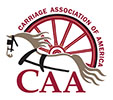
The Brougham (pronounced “brooam”, “broom” or “brohm”) is a familiar sight in Victorian era movies and books. The four-wheeled, one-horse carriage was very popular during the 1800s, owing its name and design to Lord Chancellor Brougham, a fashion forward gentleman. The Lord Chancellor wanted a vehicle for a gentleman, built along the lines of a cab, while stressing that it be light enough for a single horse to pull. With his plans he went off to see his coachbuilders Messrs Sharp and Bland of South Audley Street, London, England. They proved to be too conservative, and so Lord Brougham took his commission to Messrs Robinson and Cook. In the spring of 1838 or 1839 the first Brougham was completed!
Prior to its construction there was no enclosed carriage designed to be pulled by one horse. This carriage also claims the distinction of being the first to have elliptical springs.

Date:1850–70
Medium:Pen and black ink, watercolor and gouache with metallic ink and gum arabic
In the late 1890’s it was claimed that the Brougham was the lightest of the closed carriages, weighing only 17 cwt (1,904 pounds). At the time, a single horse and Brougham could be hired from a London jobmaster for £200 a year if the hirer promised to keep within a seven-mile radius. This was to prevent horses from being driven for long distances at a fast pace.
Lamps:
The September 1885 edition of Saddlers, Harness Makers, Carriage Builders’ Gazette refers to the lamps as being black in color and square in shape with round heads.
Carriage Accessories:
The Brougham was very adaptable to fit circumstances. A luggage rack could be added to the top to become a Station Brougham. Safety features included an opera board. The purpose of an opera board, when raised, was to protect the rear panel of the vehicle from the pole of a carriage following too closely in the rear. When the board was let down it acted as a footboard for servants. A sword case could be added. Sir Walter Gilbey even devised a means of overhead ventilation so that tobacco smoke could escape without the windows being opened.
Brewster Brougham:

By looking at the Brewster records we can learn about the type of springs used, their length, and the weight of the vehicle as well as information about the trim and paint.

Resources: The Encyclopedia of Driving by Sallie Walrond and Carriage Terminology: An Historical Dictionary by Berkebile
